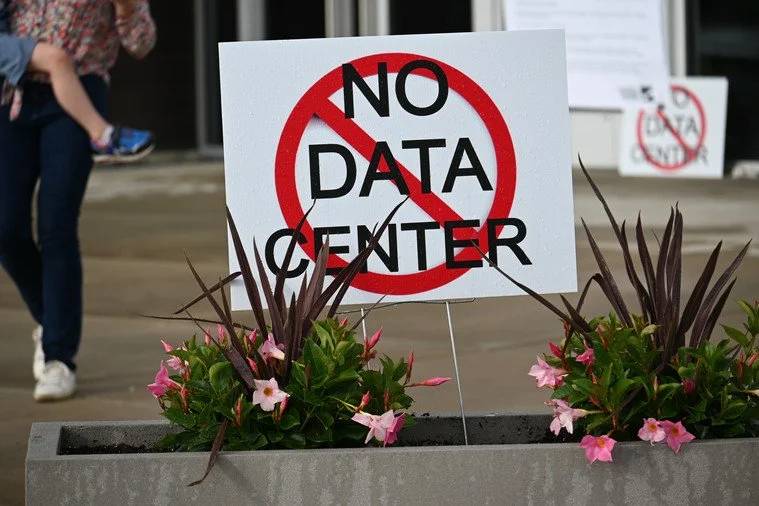Rapid response Campaign: Data centers
JTNWI has started to organize on the ground in Michigan City and will soon be launching a full campaign to respond to the surge of proposed data centers in Northwest Indiana.
Data centers are large-scale facilities that house computers and servers and are rapidly expanding at a scale never before seen due to the rise of Artificial Intelligence (AI). Most major tech companies like Google, Microsoft, Amazon, and Meta rely heavily on data centers. Amazon’s sprawling data center campus in New Carlisle, occupying 1,200 acres and consuming 2.2 gigawatts of energy, is poised to become one of the largest in the world.
What are the impacts of data centers?
-
Research forecasts that the global power demand from data centers will increase 50% by 2027 and by as much as 165% by the end of the decade. Studies found that 70%, or $9.3 billion, of last year's increased electricity cost alone was the result of data center demand.
Due to the large number of data centers that are already proposed across Northern Indiana, it is projected that these facilities alone will use more electricity by 2030 than all 6.8 million Hoosiers use in their homes today.
Region residents pay the highest electric rates in the state, with a recent increase of $50, or 26.7% per month in just one year, compounding a 17.8% hike in 2024, on an average NIPSCO bill.
The proposed utility spinoff, NIPSCO GenCo, recently approved by the Indiana Utility Regulatory Commission and has drawn objections from the LaPorte County Commissioners, will be exempted from regulatory oversight on new power generation for data centers. This exemption would also allow GenCo to negotiate rates directly with companies, potentially undermining necessary protections for ratepayers.
-
Data centers consume millions of gallons of water and massive amounts of energy daily. They can create extreme disturbances through air, water, noise, and light pollution, as well as agricultural impacts, and are largely self-regulated.
Backup generators used at these facilities, like diesel backups, emit particulate matter, increasing the risk of respiratory and cardiovascular diseases, cancer, and neurological disorders. Children have faster breathing rates than adults, which means they inhale even more toxic fumes; therefore, exposure to diesel pollution can cause stunting in children, potentially having permanent effects on their cognitive and physical development.
The Boston University School of Public Health estimates that “at only 65 decibels, about as loud as a car going by for someone standing on the side of the road, research has shown that people begin experiencing increased risk of hypertension and heart attack.”
-
NIPSCO projects at least 2,600-megawatts (MW) of new data center demand by 2028, rising to 8,600 MW by 2035.
NIPSCO is currently conducting a study to evaluate the feasibility of converting the Michigan City Generating Station (MCGS) coal-burning plant, scheduled for full decommission by 2028, to gas or other energy technologies.
Due to the growth of data centers across Northern Indiana, NIPSCO may keep the MCGS open, contributing to continued exposure to health-harming and climate-harming emissions.
This concern is already playing out, as NIPSCO just announced plans to construct a new 2,300 MW gas-fired power plant at the Schahfer Generating Station to serve the region's data centers. This is in addition to the site’s proposed 400 MW peaker plant and the existing coal units. This represents a significant shift from the utility’s prior commitments to transition away from fossil fuels, which NIPSCO projected would save customers approximately $4 billion over 30 years.
The plant is projected to emit the equivalent of 7 million tons of CO2 each year, making it the third-worst greenhouse gas emitter alongside U.S. Steel’s Gary Works steel mill and Duke Energy’s Gibson coal plant.
-
Data centers rely on water-intensive cooling systems that consume millions of gallons of potable (drinking) water annually.
According to research, a single data center can consume up to 5 million gallons of drinking water per day, enough to supply thousands of households or farms.
Not only do data centers consume large quantities of drinking water, but they also remove it from the local water cycle. The water used is often treated with chemicals to prevent corrosion and bacterial growth, rendering it unsuitable for human consumption or agricultural use.
Closed-loop systems, though viewed as the greener option, also rely on a myriad of additives. These include those containing known carcinogens, such as corrosion inhibitors, biocides, and antifreeze blends. Because the same water loops repeatedly, anything that does not evaporate or break down simply accumulates with salts, metals, and treatment chemicals, resulting in concentrations well beyond established limits. When ultimately discharged in what is known as a blow-down, it can carry nitrite, glycol, and heavy metals at thousands of times the limits set for surface waters.
-
In 2019, the Indiana General Assembly enacted House Bill 1405, the Indiana Data Center Tax Incentive Act, which provides large data centers with a full sales tax exemption for up to 50 years, while also allowing local governments to enact property tax exemptions.
In 2025, Indiana passed House Bill 1601, “Quantum Research Tax Incentives,” which exempts the sale of qualified data center equipment, quantum computing research tools, advanced computing devices, and defense infrastructure equipment from sales tax that meet specific qualifying criteria.
These subsidies are expected to total in the tens of billions of dollars in lost tax revenue for the State of Indiana over the coming decades.
-
Data centers house server farms that store our information, along with electrical equipment that gets hot, requiring 24/7 air cooling that annually uses millions of gallons of water as a refrigerant.
The average server utilization rate hovers between 12%-18% of capacity, while an estimated 10 million servers sit completely idle, equaling $30 billion in wasted capital.
Even active services rarely exceed 50% utilization, as the majority of our existing compute infrastructure is essentially burning energy without doing anything productive.
E-waste is another serious waste issue. Servers and graphic processing units, essential to data center operations, are typically replaced every 2–5 years, producing millions of tons of outdated equipment, more than 80% of which is discarded, leading to 1.2-5 million tons more of e-waste.
Data centers in indiana
Indiana is quickly becoming an epicenter for AI-focused data centers due to access to fiber optic cables, high-voltage transmission, and major information-demand regions like Chicago.
So, why Indiana? The state has affordable land and access to water needed for cooling, in addition to having a relatively low risk of natural disasters that could interrupt the electricity supply. The state also draws power from both the PJM (Pennsylvania-New Jersey-Maryland interconnection) and Midcontinent Independent System Operator (MISO) regional grids.
Approximately 60 data centers are operating in Indiana, with another 30 proposed for development.
Michigan City spotlight: Data Center Timeline
Phoenix Investors, a Milwaukee-based real estate firm, plans to redevelop the former ANCO windshield wiper factory into a $832 million data center for an undisclosed end-user under the shell corporation Lavender Fields Holdings LLC, which is believed to be Google, as suggested through public records, at 402 Royal Road. The facility, dubbed “Project Maize,” although it creates hundreds of temporary construction jobs, is predicted to create as few as 30 permanent jobs by 2034 and is using non-union, scab labor, causing the facility to be the subject of ongoing protests by the International Union of Operating Engineers.
If the data center reaches its investment threshold, the state will waive up to $42 million in taxes over a 35-year period. It will also receive a complete state sales tax exemption, including on all utilities and equipment, for more than 50 years. These subsidies for data centers, totaling $1.7 billion per data center for electric utilities sales tax exemption alone, will divert billions from everyday taxpayers and essential services over the coming decades.
The Michigan City data center will operate in direct proximity to residential neighborhoods, local schools, and a municipal golf course, posing serious risks to Michigan City communities.

Make Your Voice Heard:
Jasper County rezone
On December 15th, after hearing hours of comments from concerned community members, the Jasper County Plan Commission provided an unfavorable recommendation to the County Commissioners for NIPSCO’s proposal to rezone land at its Schahfer Generating Station in Wheatfield for a massive new gas plant and a data center, in addition to a peaker plant currently under construction. Join us in urging the Jasper County Commissioners to uphold the recommendation of their Plan Commission by signing & sharing this petition today.
midwest Report
Check out this report from the RE-AMP Network that provides an important overview and detailed analysis of the Midwest data center landscape.

